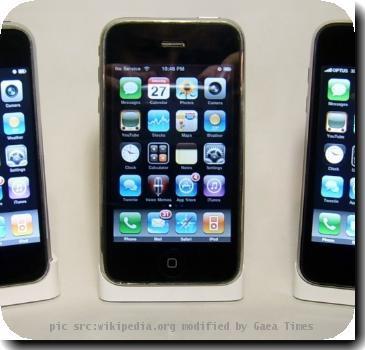For some folks, one more gadget is one too many _ no matter how cool and shiny and new
By Jocelyn Noveck, APThursday, January 28, 2010
When is one more gadget just too many?
NEW YORK — Kira Marchenese works in online communications, and so she arrived on a business trip to New York earlier this week equipped with all the gadgets you might expect: personal smart phone, work smart phone, laptop, iPod touch.
Problem is, her hotel room didn’t have enough outlets to keep the darned devices charged. “I unplugged the lamp and still couldn’t do it,” she noted ruefully. “At least half the things I’m carrying right now are just dead hunks of metal.”
And so, though communications is her world, Marchenese has no plans to rush out and buy the iPad, Apple’s new tablet device unveiled with much fanfare on Wednesday. She just doesn’t see the need for yet another gadget.
Nor does Ray Bowman, a self-described “techno-junkie” who lives on a farm in Kentucky, raising sheep some 60 miles from the two nearest Apple stores.
Bowman spent Wednesday eagerly following the news of Apple CEO Steve Jobs’ presentation, via Twitter, Facebook and wherever else he could find it. “I can’t wait to see what this puppy is capable of,” he enthused beforehand.
And yet by Thursday, he’d decided not to jump in, even though he still plans to swing by the Louisville store when the iPad is in, just to examine it in his own hands.
“I’ve seen the hype and the afterhype,” said Bowman, 58, executive director of an agriculture-oriented nonprofit organization. “I’ll stick with my netbook. Right now, I can’t see making the switch.”
Marchenese and Bowman use at least seven devices between them. Are they indicative of a cultural tipping point, a sense of general gadget overload? Steve Jones, a historian of communication technology, has seen signs of it, and believes it’s at least partially connected to the state of the economy.
“I think we’re at the point where we’re getting a little more mileage out of our old gadgets, being a little more budget-conscious,” says Jones, a professor at the University of Illinois at Urbana-Champaign.
“There’s a significantly growing culture of people tweaking their old technology to keep it useful,” Jones says. “For some, it’s actually a point of status now to get more mileage out of their gadgets.”
How many gadgets do we own, anyway? The average teen has 3.5, according to figures compiled in September by the Pew Research Center’s Internet & American Life Project and provided to The Associated Press. Adults between 18 and 29 averaged nearly four gadgets, those between 30 and 64 just under three.
Seen from another vantage point, the average household owns about 24 electronic gadgets, according to the Consumer Electronics Association — a figure that includes TVs, mobile phones, computers, and home receivers.
It shouldn’t be surprising, then, that consumers are getting harder to convince with each new gadget that comes along.
“The last decade was defined by mass adoption,” says Shawn DuBravac, the association’s director of research. “We loaded up on gadgets. The next decade will be defined by refinement, and a refocus on usability and functionality.”
Debby Abbott sees it both ways. “I’m a techno-geek,” confesses the 48-year-old college administrator, who also followed Apple’s presentation on Wednesday, and pronounced herself “salivating” over the iPad.
Make no mistake, Abbott says: She plans to own it. Well, eventually. First, she wants to wait for the second generation, when the kinks have been worked out and the price, now $499 and up, may be lower.
She’s also decided to wait until her 8 1/2-year-old iBook finally crashes — something she expects (and maybe hopes) to happen soon. Finally, she’s awaiting this year’s income tax refund.
“I’m frightened that I want this,” says Abbott, who works at Harper College in Palatine, Ill. “With the monthly fee for my iPhone, and the monthly for this, it’s getting to the point where the average person can’t afford this stuff.”
For others, it’s also a matter of scarcity, not of money but time — time to set up and really learn how the things work.
“Every new device is an investment in time,” says Marchenese, 36. “The whole power of the device is that you can set up all these apps — but that doesn’t happen by itself. And if you’re not going to make the most of it, why have it?”
That’s all part of a general feeling of conflict many have about their devices, says Lee Rainie, director of Pew’s Internet project. A December 2007 study, he says, showed that “Lots of people have conflicted views about their gadgets. On the one hand they can be expensive and time-consuming … on the other hand they help people navigate their social and information worlds and can make life easier or more exciting.”
And it’s the excitement that takes over when a cool new toy emerges, says Jeffrey Cole, director of the Center for the Digital Future at the University of Southern California.
“Yes, we are really deviced out, tired out, overburdened,” Cole says. “And all that goes out the window when a must-have device appears. We still fall for this stuff.”
Matt Scatchell seems to have already fallen hard for the iPad.
The high school senior in Avon, Conn., was in school Wednesday but received constant text alerts of the Apple presentation on his cell phone, via a Web site for Apple enthusiasts. He scoured them even as he traveled with his hockey team to a game. Nothing surprising for someone who waited 13 hours on line to buy an iPhone — for someone else. (He had sold his spot in line on Craigslist.)
“I was getting more and more excited as the press conference went on,” Scatchell says. “I think the iPad is excellent. Apple has the most efficient touch screen around.”
But youth’s impetuosity has not carried the day. He, too, is not ready to buy the device.
“Most kids my age aren’t pragmatic enough,” says Scatchell, who obviously is. “I want to see if I can really use this. I don’t want to get carried away just ’cause it’s the next cool thing.”
Tags: Communication Technology, Computer Hardware, Computing And Information Technology, Consumer Electronics, Ipad, Mobile Communications, New York, North America, United States


Use gadget